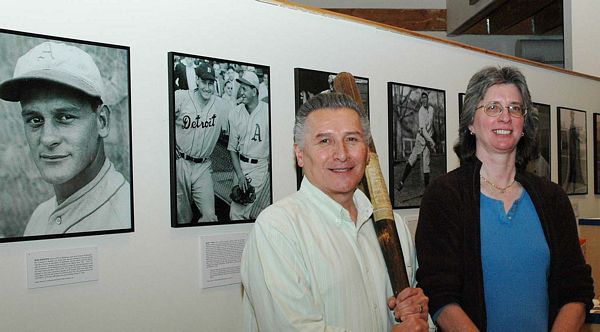Subscriptions
Menu
Advertisements
Exhibit highlights Indians and baseball
3/26/2008 |
By Jim Poole |

An ambitious exhibit that pulls together art, history and sports is coming to the Iroquois Indian Museum in Howes Cave on Tuesday.
Timed to begin with baseball’s opening day, “Baseball’s League of Nations: A Tribute to Native American Baseball Players” explores Indians’ rich history in baseball.
The exhibit looks at all levels of baseball, and the men––and women––who played, from museum Educator Mike Tarbell’s family history with baseball to present day Native players, such as the Yankees Joba Chamberlain and the Red Sox Jacoby Ellsbury.
For a museum rooted almost solely in art and history, the exhibit is a new thrust.
Why baseball?
Curator Stephanie Shultes is a big baseball fan, and she knew of Mr. Tarbell’s interest. And both were aware of many Indians who played major league ball.
“When Mike would talk about baseball, he’d just light up,” said museum Director Erynne Ansel-McCabe. “This was a natural fit for us.”
The exhibit is divided into several sections: boarding school baseball, including the Carlisle Indian School, where Jim Thorpe played; community baseball; pro ball, including majors and minors; Native women in baseball, mostly Iroquois; stereotypes; and players who were or are part Indian, but whose ancestry isn’t widely known, such as Bucky Dent and Early Wynn.
There’s a sharp focus on the late 1800s and early 1900s major leagues, when nearly every Indian playing ball––and breaking the color line––was nicknamed “Chief,” pitcher Chief Bender and catcher Chief Meyers among them.
The exhibit takes visitors through later years and players and touches on the difficulty some had in dealing with non-Native culture.
“I think it shows that Native people are just like everyone else,” said Mr. Tarbell.
“A lot of times, they mention that it was a good experience, and the rough treatment didn’t bother them. But once in a while. . .”
Large photos and biographies line one wall of the exhibit, and cases display baseball cards, gloves and uniforms, including St. Louis Cardinal Pepper Martin’s hat from his Gashouse Gang days of the 1930s.
About a dozen items are on loan from the Hall of Fame in Cooperstown.
“We called the Hall of Fame and talked about the idea, and they said, ‘How fast can you get here?’ ” Ms. Ansel-McCabe said.
One prized item is Charles “Chief” Bender’s bat, a long, heavy piece of lumber on loan from the Seneca Iroquois National Musuem.
And then there’s Mr. Tarbell’s connection.
A Mohawk, Mr. Tarbell grew up on the edge of the Onondaga Reservation. His mother wanted him to be involved with non-Native activities as a way to assimilate. Baseball was an avenue.
At a family picnic, an uncle discovered the boy had a live arm.
So he became a pitcher, throwing three years with the Syracuse Ramblers of the State League, a semi-pro loop.
But the Vietnam War intervened, and Mr. Tarbell threw out his arm tossing a heavy grenade.
He later broke his leg, and the combination of injuries ended a possible college career.
In another family link, Mr. Tarbell’s great uncle Joe pitched for the Carlisle Indian School team that beat Army, coached by Pop Warner.
“The Indians finally beat Army,” Mr. Tarbell chuckled.
The experiences he and his uncle had were similar to those of other young Native men playing baseball, Mr. Tarbell said.
“Boys would play ball or go to a boarding school and play, and they’d bring baseball back to the reservation,” he said. “It was a way of assimilation.”
Ms. Shultes is finishing her work assembling the exhibit, but she believes it will change and be added to after the opening.
“I think people will offer things or bring something that we couldn’t find or didn’t know about,” she said. “It will change and expand.”
The exhibit will be the first to travel from the museum. After closing in December, it will move to the Stamford Museum & Nature Center in Connecticut.
“Everybody’s excited about this because it crosses a lot of boundaries,” Ms. Ansel-McCabe said. “There’s a lot of energy here. These people deserve to have their story told.”









